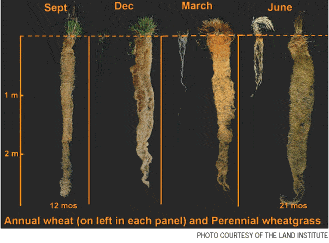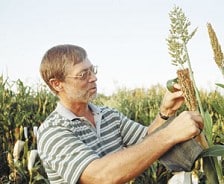A prairie of row crops
Universities and a private research foundation search for earth friendly plant matches

For the last 11 years, Stan Cox has shown up for work knowing that the task at hand might not be finished in his lifetime.
That’s fine by him. The task, developing perennial crops along with colleagues at The Land Institute in Salina, Kan., could change the nature of agriculture for several lifetimes.
The nonprofit organization was founded in the 1970s with a mission to find alternatives to farming practices that its co-founders believed were as destructive as they were productive.
Since 2000, the focus has been solely on producing perennial crops from native plant and grass species, Cox said. Perennials propogate themselves year after year.
Resistance to The Land Institute’s research came from skeptics who believed the researchers could not achieve their goals. The majority of the organization’s funding comes from individuals and foundations that believe contemporary farming practices exhaust the land, foul the environment and are impossible to sustain. In 2009, The Land Institute had revenues of about $2.5 million.
Funding is an issue. There are no corporate dollars from large seed companies fueling the research in perennial crops, and public dollars are scarce.
“For the federal funding agencies, the message they have received is that in commercial corn production, the private sector can take care of that,” said William Beavis, interim director of Iowa State University’s Plant Sciences Institute and a former researcher at Pioneer Hi-Bred International Inc.
“Pioneer spends $800 million a year on research, four times more than the USDA funding budget share for people working with all agriculture-related research,” he said. “Investors want a return, and that means selling seed corn every year.
“There’s not a good business model in something you sell every five years or 10 years. If the priority were on stabilizing the loss of the soil and there were a return for people who invested in it, then we would have a marketable model.”
On the other hand, a desire to protect the environment while reducing costs for farmers and maintaining the high yields that are demanded by growing appetites for food and fuel is behind research at Pioneer into a corn hybrid that requires reduced levels of nitrogen.
It is that kind of thinking that could change the nature of farming in Iowa and the world.
“In the last two or three years, there has been a torrent of enthusiasm for perennial crops,” Cox said. “We have seen statements that are positive about perennial grain crops coming from a report from the National Academy of Sciences, notes in the last farm bill, articles in Science and Nature, and some other highly respected places.
“People are thinking that perennials have an advantage, so we ought to get it done. I’m not sure whether it’s an idea that had to incubate for a while, but it has become respectable now to talk about it.”
In addition to The Land Institute, research into perennial crops is happening at Iowa State University, primarily the search for crops that will thrive on land that provides marginal yields of corn and soybeans, and a relative handful of other universities. A U.S. Department of Agriculture (USDA) research scientist at Cornell University in Ithaca, N.Y., is looking for perennial corn.
Chad Hart, an assistant professor of economics at Iowa State, said the commercialization of perennial corn would forever change the face of agriculture.
“That would be a whopper,” he said. “It just depends as we look at these perennial varieties, can we get close to the annual varieties? Can we find yields that can compete? If it were an easy problem, we probably would have found an answer by now.”
Regardless of the species, the quest for a crop that doesn’t require annual planting is no easy task. Cox said it could be decades before his research into perennial sorghum produces a marketable variety. The Land Institute will make its research available to anyone interested in carrying such a product to market.
Iowa State is hosting a small stand of perennial corn in one of its greenhouses. However, the researcher working on that project is out of the country, and a fellow scientist at the university’s Plant Sciences Institute joked recently that he was not sure where to find the sample.
“There’s a little bit of the research going on here; I would call it skunk work,” Beavis said. “It’s definitely below the radar; people screening corn germ plasm, seeing if it will perennialize.”
Beavis and Cox said the bulk of the work on perennial corn is being done at Cornell.
The work at Cornell is focused on eastern gama grass, a warm-season native that is related to corn and is hardy enough to survive bitter Midwest winters, Cox said. The Land Institute has decided to focus on species that it is familiar with and leave corn research to other institutions, he said.
“The corn work is going to be a major task and cost quite a bit of money, and we thought we should stick to our own species,” Cox said in explaining why The Land Institute has decided not to conduct research into perennial corn.
Ed Buckler, the Cornell researcher who Cox said is the most focused of all scientists investigating perennial corn, could not be reached for comment. However, he has said in other publications that developing the hybrid for market could cost $10 million to $20 million.
Cox, who is familiar with the research, said perennial corn already can grow in the subtropics but cannot survive in northern climates. For now, Buckler is in the initial stages of genetic testing to find a suitable match to produce perennial corn.
Another problem confronting all researchers is that plants don’t carry an obvious signal as to why they can survive year to year.
“There isn’t a perenniality gene,” Cox said.
The Land Institute’s search for an alternative to crops that must be planted year after year isn’t based on a criticism of farming practices, monolithic seed companies, herbicide manufacturers or producers of fertilizers. It is based on a criticism of the annual crops and their need to be cultivated and fertilized, debugged with pesticides and kept weed-free with herbicides as farmers meet demands for increasing appetites for food and fuel.
The villain in the production of annual plants is Neolithic man, who discovered more than 10,000 years ago that seeds planted anew each year produced higher yields than their native relatives.
“Perennial crops are not necessarily an end in themselves,” Cox said. “The Land Institute view has always been that in whatever part of the world you are trying to grow field crops, the closer that agriculture is to the original vegetation, the more likely you are to have the ecological benefits that we had before agriculture. When you look at vegetation before agriculture, 95 percent was diverse mixtures of perennial plants.”
The advantage of crossing annual plants with native perennials is that the natives generate deep root systems that better manage water and nutrients and prevent soil erosion. Annual plants form shallow roots, expending their energy on seed production and requiring constant and expensive nurturing.
The Land Institute is focusing on a handful of native species: Illinois bundleflower, a legume that approaches soybeans in protein content; intermediate wheatgrass, a forage crop that is being crossed with annual wheat; a sunflower-like plant called Jerusalem artichoke that could be crossed with annual sunflower species; and two members of the sorghum family: an invasive perennial called Johnson grass and grain sorghum, an annual that is used for forage and food and is being touted for its potential as a biofuel source.
Grain sorghum is a candidate, in part, because “it doesn’t know when to die,” Cox said, until it gets very cold.
The problem with crossing annuals and perennials is that a plant that renews itself every year loses some vigor over time. The annual produces larger seed heads and offers better yields for farmers.
In his research, Cox is walking a razor’s edge between the benevolent and malevolent. Johnson grass is listed by some organizations as one of the world’s most threatening invasive species. Although it is used as forage, it can become toxic to cattle under certain conditions, and in some regions it is resistant to glyphosate herbicides, such as Roundup. According to the USDA, it is a problem in a handful of counties in Iowa.
Grain sorghum, whether it’s perennial or annual, barely registers in the annual crop planning of Iowa farmers. A mere 2,700 acres were planted to the grain and food crop in 2007, according to Iowa State’s Leopold Center for Sustainable Agriculture. Sorghum is such a minor crop in Iowa that the USDA doesn’t track its production in the state.
Nonetheless, sorghum could take some of the strain off corn and soybeans in the search for a productive biofuel.
The Land Institute is committed to perennial research for the long haul.
“Plant breeding is never finished, so it’s hard to say how far we are to a particular target,” Cox said. “We can stand on the shoulders of giants to some extent, especially where we are working with modern crops. … In a lot of ways, what we are doing is not all that different from what our ancestors did 10,000 years ago.”

This photo demonstrates the differences between the root systems of annual wheat and perennial wheatgrass. Researchers like long roots.











